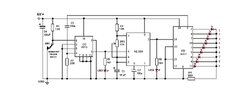I have a circuit that works perfectly. When the normally closed switch is pulsed, the LEDs sequence from 1 to 9 and then the circuit resets and switches off the LEDs. This works using a 4013 flip flop. (fig. 1).
However, I now need the circuit to work with a normally open trigger switch. I can do this by adding an additional relay. It's normally closed contacts replace SW1 and when the relay is energized, the contacts break and trigger the sequencer circuit. (fig 2).
My question is, is it possible to re-configure the 4013 to trigger with a normally open switch, obviating the need for the additional relay?
Any help would be much appreciated.
However, I now need the circuit to work with a normally open trigger switch. I can do this by adding an additional relay. It's normally closed contacts replace SW1 and when the relay is energized, the contacts break and trigger the sequencer circuit. (fig 2).
My question is, is it possible to re-configure the 4013 to trigger with a normally open switch, obviating the need for the additional relay?
Any help would be much appreciated.




